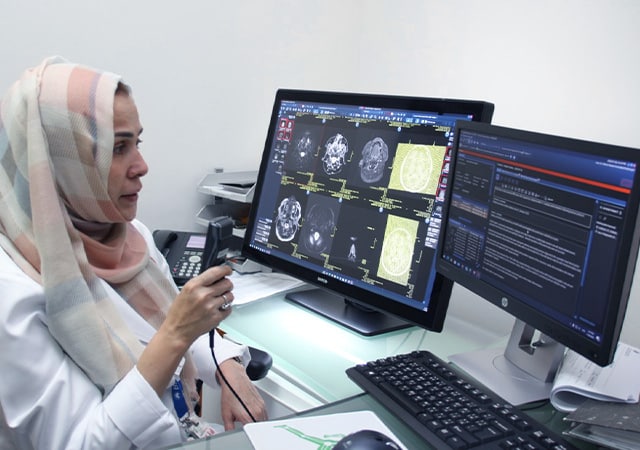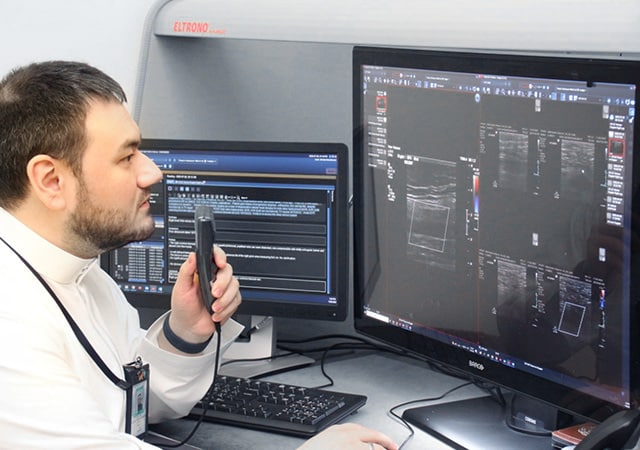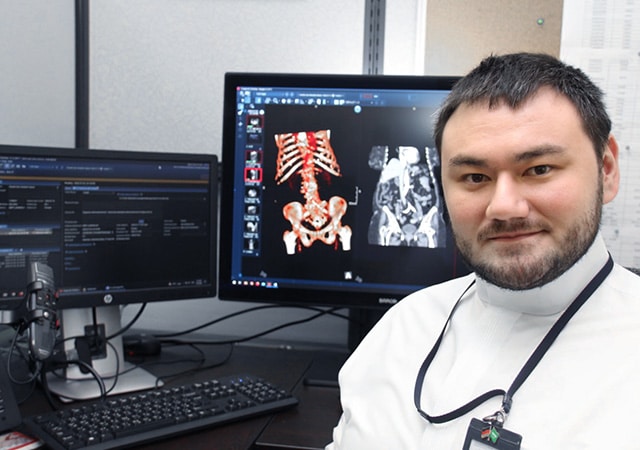Customer Case Study
King Abdullah Medical City, Makkah

Overcoming the implementation challenges of COVID-19, this specialist healthcare facility in the Kingdom of Saudi Arabia is enhancing patient care and radiologist workflow with AGFA HealthCare’s modern, unified imaging platform.
King Abdullah Medical City in Makkah upgrades to the consolidated AGFA Healthcare Enterprise Imaging platform.
Meet the team:
Dr. Elham Rawah
Head of Radiology
Cardiothoracic radiologist
On-call radiologist
Case study
In 2021, long-term AGFA HealthCare customer King Abdullah Medical City (KAMC) in Makkah (Mecca), Kingdom of Saudi Arabia, upgraded its former AGFA HealthCare image management system to Enterprise Imaging. This converged platform has enabled the hospital to enhance patient care, with a broad range of tools that speed up reporting, increase radiology productivity, and improve the work/life balance of the radiologists.
Advanced needs for a specialist hospital
KAMC is a specialist healthcare facility committed to providing the highest standards of quality and excellence in patient care. As the head of a cluster of hospitals run by the Ministry of Health, it handles more complex patient cases that cannot be treated in the primary or secondary care facilities. The radiology department serves oncology, neurology and cardiology patients, and offers nuclear medicine; musculoskeletal, body, women’s, neuro and cardiothoracic imaging; and interventional radiology.
The relationship between KAMC and AGFA HealthCare first took off in 2011, when an AGFA HealthCare picture archiving and communication system (PACS) was installed at the hospital. After several upgrades over the years, this system had reached its end of life. “The PACS had become outdated, and it couldn’t be integrated with new technologies. Furthermore, it didn’t provide the advanced features that are needed today by a tertiary radiology center like ours,” explains Dr. Elham Rawah, Head of Radiology at KAMC.
After a competitive tender, AGFA HealthCare was again chosen to supply the new system: the Enterprise Imaging consolidated platform. Past, present and future possibilities all played a role in this choice, explains Dr. Rawah: “The platform offers the tools we need today, while allowing us to add more tools in the future. And when we switched from the previous AGFA HealthCare PACS, it was easy to comprehend and adapt to Enterprise Imaging.”
“For the radiology staff, Enterprise Imaging has made working ‘on the go’ and at home much simpler.
For instance, they can share cases, create teaching files, and discuss findings and issues via chat, all remotely.”

Up and running with nearly zero downtime
After backing up the previous PACS servers, installing the new Enterprise Imaging servers, and running online and offline tests, KAMC and AGFA HealthCare were ready for the go-live of the new platform. Thanks to the careful preparation and teamwork, this was achieved with nearly zero downtime, in March 2021.
“Both our team and the AGFA HealthCare team were on-hand for the first 96 hours, and they quickly dealt with any small hiccups. Thanks to their cooperation, the system was fully operational by the second week,” explains Dr. Rawah. “Despite the 10-year gap in technology between our previous PACS and Enterprise Imaging, the adoption was very smooth, likely due to the very user-friendly Enterprise Imaging interface, and the 24/7 technical support.”
Training during the COVID-19 pandemic also presented some unique challenges. “We had to avoid clustering and overcrowding, so on-site staff training was spread out over three to four weeks. Then one-on-one training with the AGFA HealthCare engineers was carried out for specific software like nuclear medicine, cardiology and musculoskeletal imaging,” Dr. Rawah describes.
Today, the basic functions for all of the sub-specialties are working perfectly, says Dr. Rawah. Over 100 staff members use the platform, including physicians, technicians, receptionists, quality facilitators and administrators.
Did you know?
- Makkah is not only the third-most populated city in the Kingdom of Saudi Arabia, but also a holy city welcoming almost 2.5 million pilgrims each year.
- Founded in 2010, King Abdullah Medical City is a 1550-bed quaternary specialized healthcare facility with three campuses: a 550-bed quaternary hospital in Makkah with multiple centers of excellence including cardiovascular, neurosciences, oncology and specialized surgery, an oncology center in Jeddah, and a 1000-bed quaternary healthcare facility between Jeddah and Makkah.

Delivering workflow and productivity benefits
“Like any change, switching to Enterprise Imaging has been a learning curve,” says Dr. Rawah, but enhanced workflow and productivity benefits are already being felt. “For the radiology staff, Enterprise Imaging has made working ‘on the go’ and at home much simpler. Collaboration is also easier. For instance, radiologists can share cases, create teaching files and discuss findings and issues via chat, all remotely.” The ability to confer with colleagues in real time about specific findings reduces reporting time, while improving the quality of the information.
Enterprise Imaging tools and hanging protocols make analyzing and comparing studies – or even CDs from other facilities – more efficient. “We can specify a layout according to a study’s planes and type, which improves the speed and consistency of reporting. It also makes it easier to detect new small lesions in our cancer patients. Creating a macro or text template is easy, and encourages systematic evaluation of the scans. And it helps for the training of our junior colleagues,” adds on-call radiologist Dr. Mohammad A. Bokhary.
Furthermore, as cardiothoracic radiologist Dr. May Bejad Alsharif explains, “The Enterprise Imaging software is designed to facilitate the radiologist’s workflow, by creating an overview list according to required tasks such as order reviews, scan protocoling and reporting.”
The radiologists themselves have noticed the improvements in their workloads, thanks to the remote reporting workflow, for instance. “Enterprise Imaging supports a better work/life balance for the radiologists, even as they continue providing the highest level of patient care, quality of service and reporting,” Dr. Rawah says. “In addition, the remote access enables faster response for critical cases during nights or weekends, even when the on-call radiologist lives 100 kilometers away from the hospital.”
“Reporting critical and incidental findings is easy and intuitive; it takes only a few moments, and eliminates situations where we must search for the primary physician, and perhaps not find them”

Critical findings notification
Enterprise Imaging’s automatic critical findings notification via SMS enables the radiologist to immediately inform the primary physician, without losing time trying to reach them by phone.
This means the primary physician gets the critical information more quickly, which enhances the delivery of patient care and treatment, while the radiologist can move on to more value-added tasks.
“Reporting critical and incidental findings is easy and intuitive; it takes only a few moments, and eliminates situations where we must search for the primary physician, and perhaps not find them,” describes Dr. Bokhary.
Enhancing clinical confidence and the delivery of care
The new tools available in Enterprise Imaging are also improving patient care. Specialized applications, including advanced visualization and 3D, provide information that help support confident diagnoses. Dr. Rawah specifies, “These tools help our radiologists to pick up small and fine details that were less easily discovered with the previous system. Furthermore, the platform provides us with direct access to other tools we use, such as SPECT and PET, which definitely adds a new level of interpretation and accuracy.”
“Viewing large-sized studies, such as multiphasic abdomen CTs, is now much faster and more reliable for the urgent detection of life-saving findings during on-calls,” adds Dr. Bokhary.
The embedded, advanced clinical tools also facilitate quantification and qualification assessments of cardiovascular structures. “To give one example, with the pre-procedural CT Evaluation of Transcatheter Aortic Valve Replacement (TAVR) workflow, the advanced clinical application can estimate the aortic valve anatomic and detailed measurements, before intervention, supporting informed decision-making,” says Dr. Alsharif.
Another advantage of the new Enterprise Imaging platform is that it enables radiology to calculate a patient’s accumulated radiation dose: an important consideration when deciding on imaging.
The advantages of the Enterprise Imaging platform are felt outside the radiology department, as well. Clinicians can access images and studies via the AGFA HealthCare XERO® universal viewer, both throughout the hospital and remotely.

Smoother scheduling and appointments save time
“Overall, the platform has improved the patient appointment system, and reduced appointment duplication,” explains Dr. Rawah. Patients receive two reminders of their appointments, along with a link to information on the hospital website regarding the preparation needed for their appointment.
“Our patients are pleased that their hospital visits are shorter and simpler. We also lose less time with patients who misplace their instruction papers and are thus not properly prepared for their exams, which can lead to rescheduling or even cancellations.”
Turning data into informed decisions
Business intelligence tools enable the department to calculate and oversee a broad range of metrics, such as the time from order to scheduling, from scheduling to exam and from exam to report, as well as report turnaround time, the total number of cases handled per staff per month, and more. “But there is still a lot more we can do with the business intelligence functionalities. For example, we would like to add administrative responsibilities,” adds Dr. Rawah.
A strong relationship, with proactive support
KAMC’s decision to continue the relationship with AGFA HealthCare, from 2011 to the present day, is a clear testimony of the support provided by AGFA HealthCare to the hospital, before, during and after the implementation of Enterprise imaging.
As Dr. Rawah explains, “AGFA HealthCare engineers are available both via a hotline and in person, and technical support is always provided when we ask for it.”
Dr. Alsharif adds: “AGFA HealthCare’s support team is always available to deliver high-quality, effective services, 24/7. Furthermore, they are proactive in approaching radiologists and radiographers for new services, and to show us valuable ways to optimize our use of the system.”
“Agfa HealthCare’s support team is proactive in approaching radiologists and radiographers for new services, and to show us valuable ways to optimize our use of the system”
AGFA HealthCare solution
- Enterprise Imaging for Radiology
- Tools for 3D and advanced visualization
- Nuclear medicine module
- Remote reporting with voice recognition
- Notification of critical findings
- Business Intelligence
- XERO Viewer:
- integrated in the EMR, which allows clinicians in the hospital to view their patients’ images in the patient’s electronic record
- integrated in the hospital’s patient portal, enabling patients and referring physicians to view images from outside the hospital
